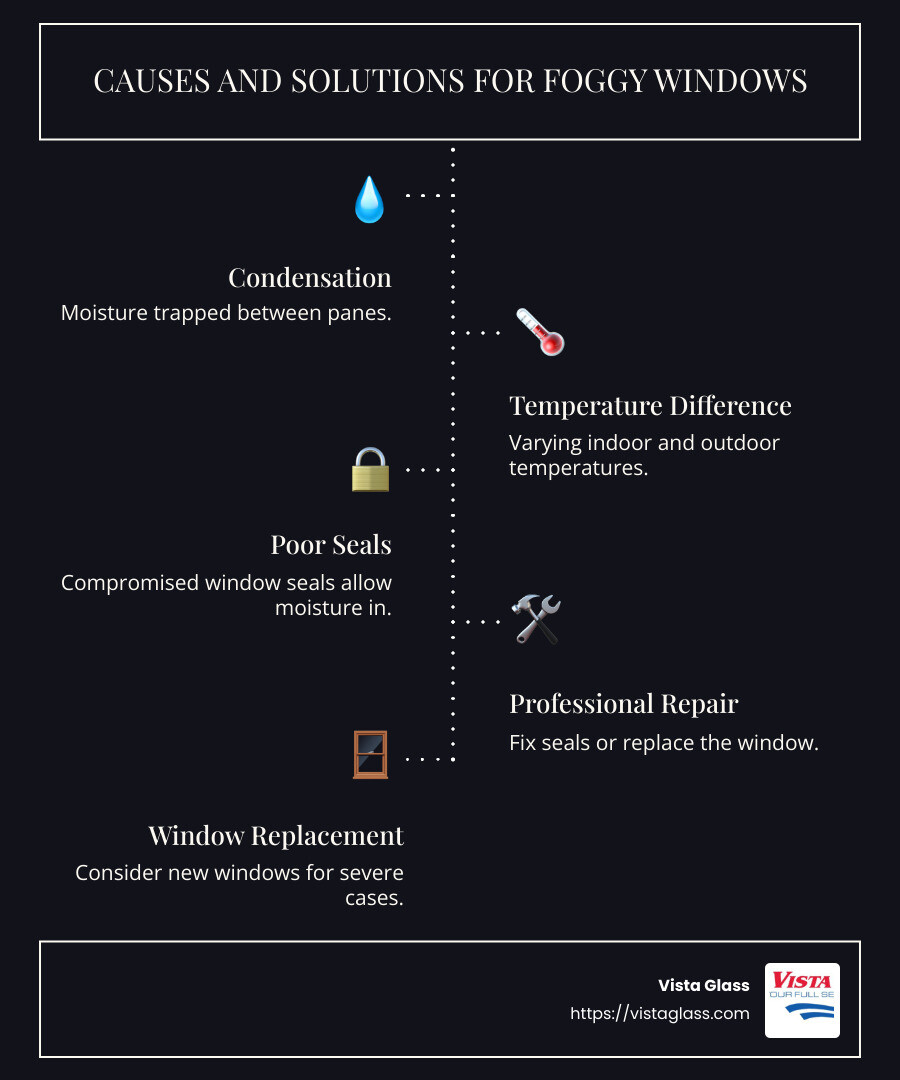Fix Foggy Windows in House: Top 5 Simple Solutions 2024
Fix foggy windows in house to improve both the clarity of your view and energy efficiency. When your windows become foggy, it’s usually a sign of trapped moisture between panes, leading to condensation that not only blurs your sight but also signals potential energy losses.
- Reason for Fog: Moisture trapped between window panes.
- Impact: Reduced energy efficiency, risk of mold, and decay.
- Primary Solution: Professional repair or window replacement.
Fog not only makes your windows look unsightly but also diminishes their insulation ability, causing your home to lose heat in winter and cool air in summer. This inefficiency can lead to higher energy costs and an uncomfortable indoor environment. Regular maintenance and timely repair can help prevent this common issue.
Hello there, I’m Rich Main from Vista Glass. For over two decades, I’ve helped countless homeowners fix foggy windows in house, ensuring clearer views and better energy efficiency. Stay with us as we explore ways to tackle this common household problem.

Similar topics to fix foggy windows in house:
– house window foggy
– old home window repair
– best home window replacement near me
Understanding Why Windows Fog Up
Windows fog up primarily due to condensation, which occurs when warm, moist air comes into contact with a cooler surface, like your window glass. This is common in homes, especially during colder months when the temperature difference between the inside and outside of your home is significant.
Condensation Causes
Condensation is the main culprit behind foggy windows. It happens when there’s a temperature difference between the inside and outside of your house. For example, during winter, the warm air inside your home meets the cold window glass, leading to moisture forming on the surface.

Temperature Differences
Windows with broken seals can exacerbate this issue. A damaged seal allows moist air to get trapped between double-pane windows, leading to persistent fogging. This is often seen in older windows where the seals have worn out over time due to exposure to elements like water and excess heat.
Quick Tip: Regularly check your window seals, especially after heavy rain or during hot summers, to catch potential issues early.
Moisture Accumulation
High humidity levels inside the house can also cause windows to fog up. Activities like cooking, showering, or drying clothes indoors increase moisture in the air. Without proper ventilation, this moisture accumulates and can lead to foggy windows.
Solution: Use exhaust fans in kitchens and bathrooms, and consider a dehumidifier to manage indoor humidity levels.
Understanding the causes of window fogging is the first step in addressing the problem. Whether it’s due to condensation, temperature differences, or moisture accumulation, identifying the root cause can help you choose the most effective solution.
How to Fix Foggy Windows in House
Foggy windows can be a nuisance, but there are several ways to tackle the problem. You can try DIY solutions or opt for professional repair options. Let’s explore both approaches to help you decide which one suits your needs best.
DIY Solutions for Foggy Windows
If you’re a hands-on homeowner, there are several DIY methods you can try to fix foggy windows. These methods can be cost-effective and relatively simple to execute.
- Vinegar Solution: Mix equal parts of white vinegar and water in a spray bottle. Spray the solution on the foggy glass and wipe it clean with a microfiber cloth. Vinegar helps to cut through the fog and clear the glass surface.
- Rubbing Alcohol: Similar to vinegar, rubbing alcohol can be used to clean foggy windows. Apply it directly to the glass and wipe it down with a clean cloth. This method is effective for temporary fogging caused by condensation on the interior side of the window.
- Shaving Cream: Surprisingly, shaving cream can act as a fog repellent. Apply a thin layer of shaving cream on the window, let it sit for a few minutes, and then wipe it off. This can help prevent fog from forming on the window.

These DIY approaches are great for quick fixes and temporary relief from foggy windows. However, they may not address underlying issues like broken seals or trapped moisture between panes.
Professional Repair Options
For a more permanent solution, you might want to consider professional repair options. These methods can restore your windows’ clarity and energy efficiency.
- Replace IGU (Insulated Glass Unit): If the fogging is due to a broken seal, replacing the IGU might be the best solution. This involves removing the old unit and installing a new one, retaining the window frame. It’s a more complex task but effectively restores the window’s insulation properties.
- Defogging: This process involves drilling small holes into the glass, cleaning the space between the panes, and then sealing it back up. While defogging doesn’t restore the lost insulation, it does clear up the foggy appearance.
- Window Sash Replacement: If the sash is damaged, replacing it can help prevent future fogging. This involves measuring and installing a new sash, which can improve both the appearance and function of your window.

While professional repairs can be more costly than DIY methods, they offer long-term solutions that can save you money on energy bills and prevent further damage to your windows.
Choosing the right method to fix foggy windows in your house depends on the severity of the problem and your budget. Whether you opt for DIY solutions or professional repair, addressing the issue promptly can maintain your home’s comfort and energy efficiency.
Preventing Future Fogging
Preventing foggy windows is about keeping moisture out and maintaining good airflow in your home. Let’s explore some effective strategies for preventing future fogging.
Proper Ventilation
Proper ventilation is crucial in reducing window fogging. When air circulates well, it helps balance indoor and outdoor temperatures, reducing the chances of condensation.
- Use Exhaust Fans: Make sure to use exhaust fans in your kitchen and bathrooms. They help remove steam and moisture, which are common culprits of window fog.
- Open Windows: Regularly open windows, especially in frequently used rooms, to allow fresh air to circulate. This is particularly important during and after activities that produce steam, like cooking or showering.
Dehumidifiers
Dehumidifiers are excellent tools for managing moisture levels in your home. They pull excess moisture from the air, making it less likely to condense on windows.
- Choose the Right Size: Ensure your dehumidifier is the right size for the room. A unit too small won’t effectively reduce humidity, while one too large could over-dry the air.
- Place Strategically: Position dehumidifiers in areas prone to moisture buildup, like basements or bathrooms, for optimal performance.
Routine Maintenance
Regular maintenance can prevent fogging and extend the life of your windows. Small, consistent efforts can make a big difference.
- Inspect Seals: Check window seals regularly for any signs of wear or damage. Replacing damaged seals can prevent moisture from seeping in between panes.
- Clean Gutters: Ensure gutters are clean and functioning properly to prevent water from pooling around window frames, which can lead to leaks and fogging.
- Weatherstripping: Apply weatherstripping to windows and doors to improve insulation and prevent drafts. This helps maintain a consistent indoor temperature, reducing the chances of condensation.
By focusing on proper ventilation, using dehumidifiers, and performing routine maintenance, you can keep your windows clear and your home comfortable. These preventive measures not only help in avoiding foggy windows but also improve your home’s overall energy efficiency.
Frequently Asked Questions about Fixing Foggy Windows
Can a foggy window be repaired?
Yes, foggy windows can often be repaired, especially when the issue is caught early. The problem usually arises when the seal around the insulated glass unit (IGU) fails, allowing moisture to get trapped between the panes.
Seal Replacement is a common repair method. By replacing the damaged seal, you can prevent further moisture ingress and restore some of the window’s insulating properties. However, if the window is old or the frame is in poor condition, it might be more cost-effective to replace the entire IGU or even the window itself.
How do you get rid of fog in inside windows?
For interior condensation, simple DIY solutions can be quite effective. Here are a few methods you can try:
- Vinegar Solution: Mix equal parts vinegar and water in a spray bottle. Spray the solution onto the foggy areas and wipe with a clean cloth. The acidity in vinegar helps break down condensation and leaves your windows clear.
- Shaving Cream: Apply a thin layer of shaving cream to the window and wipe it off. This creates a protective barrier that can help prevent fogging.
These methods are quick fixes and work best for temporary fogging caused by humidity or temperature differences inside your home.
How do you get the cloudiness out of double pane windows?
Removing cloudiness from double-pane windows is a bit more challenging due to the moisture trapped between the panes. Here are some approaches:
- Desiccate Packets: Placing desiccate packets near the window can help absorb moisture. While not a permanent solution, it can reduce fogging temporarily.
- Drilling Holes: A more involved method is to drill small holes into the glass to release trapped moisture. This is typically followed by inserting a drying agent. Then, the holes are sealed to prevent further moisture from entering. This method is best performed by professionals to avoid damaging the glass.
These techniques can improve visibility but may not fully restore the window’s original insulation value. For long-term clarity and energy efficiency, consider consulting a professional to assess whether seal replacement or IGU replacement is necessary.
By addressing these common questions, you can better understand your options for dealing with foggy windows and decide on the best course of action for your home.
Conclusion
Choosing the right solution to fix foggy windows in your house can significantly improve your home’s comfort and energy efficiency. At Vista Glass, we understand that foggy windows are more than just a nuisance—they affect your home’s insulation and your energy bills.
Our mobile service makes it easy and convenient for you to get professional assistance without any hassle. Whether it’s a simple seal replacement or a complete window overhaul, our experienced team is ready to help.
Customer satisfaction is at the heart of what we do. With over 25 years of experience, we ensure that every job is done right the first time. Our commitment to quality and service means you can rest easy knowing your windows are in expert hands.
If you’re dealing with foggy windows, don’t wait for the problem to worsen. Let us help bring clarity back to your home. Visit our glass services page to learn more about how we can assist you today.

